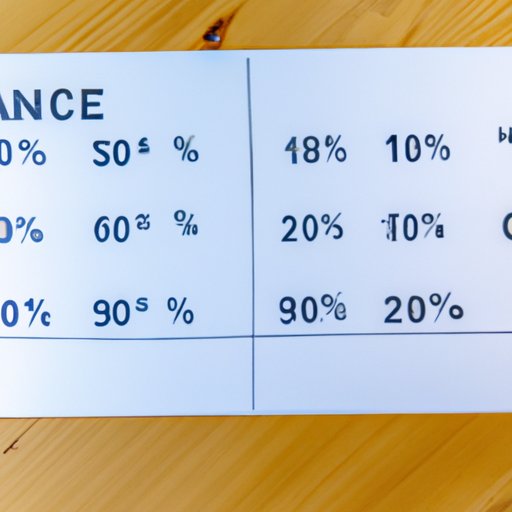
Introduction
If you’ve ever looked at a decimal and wondered what percentage it represents, you’re not alone. Decimal to percentage conversion is a common skill that many people need in their daily lives. From calculating discounts at the store to understanding interest rates on loans, decimals and percentages are two concepts that we encounter regularly. In this article, we’ll provide a step-by-step guide to converting decimals to percentages, along with real-world scenarios and practice exercises to test your skills.
Step-by-step guide
Converting a decimal to a percentage involves multiplying the decimal by 100. For example, 0.75 would be represented as 75%. Here are the steps to follow:
- Take the decimal and multiply it by 100. For example: 0.75 x 100 = 75.
- Add the percentage symbol (%): 75%.
That’s it! The decimal has been converted to a percentage. Let’s take a look at some visual examples to make this process even clearer.

Real-world applications
Now that we’ve covered the basic process of converting decimals to percentages, let’s take a look at some real-world applications:
- Calculating sales tax: Say you live in a state with a sales tax rate of 7.5%. If you’re buying a $50 item, you’ll need to calculate how much sales tax you’ll owe. To do this, you’ll need to convert the sales tax rate from a decimal to a percentage: 0.075 x 100 = 7.5%. This means that you’ll owe $3.75 in sales tax ($50 x 0.075).
- Understanding interest rates: Suppose you’re taking out a loan with an annual interest rate of 5.25%. To understand how much interest you’ll be paying, you’ll need to convert that decimal to a percentage: 0.0525 x 100 = 5.25%.
- Calculating test scores: If you scored 0.82 on a test, you’ll want to know what percentage that represents. Converting 0.82 to a percentage is as simple as multiplying by 100: 0.82 x 100 = 82%.
Practice exercises
Now let’s test your skills with a few practice exercises:
- Convert 0.37 to a percentage.
- Convert 0.95 to a percentage.
- A shirt is on sale for 20% off its original price of $40. What is the sale price?
Don’t worry if you’re not sure how to answer these questions yet – we’ll provide the answers in the next section.
Comparison with fractions
Converting fractions to percentages is a little different than converting decimals to percentages. To convert a fraction to a percentage, you need to divide the numerator by the denominator and then multiply by 100. For example, 3/4 would be converted to a percentage as follows:
- Divide the numerator by the denominator: 3 ÷ 4 = 0.75.
- Multiply by 100: 0.75 x 100 = 75%.
While both methods result in a percentage, there are some situations where it may be easier to use one method over the other. In general, converting decimals to percentages is easier and more straightforward than converting fractions to percentages.
Common mistakes
While the process of converting decimals to percentages is fairly simple, there are some common mistakes that people make. Here are a few to watch out for:
- Forgetting to multiply by 100: This is probably the most common mistake. Remember, to convert a decimal to a percentage, you need to multiply by 100.
- Misplacing the decimal: If you accidentally move the decimal point to the wrong place, you’ll end up with a completely different percentage. Double-check your work to make sure the decimal is in the right spot.
- Using the wrong formula: It’s easy to confuse the formula for converting decimals to percentages with the formula for converting fractions to percentages. Make sure you’re using the correct formula for the situation.
Historical context
Both percentages and decimal notation have a long and fascinating history. The concept of percentages can be traced back to ancient civilizations such as the Egyptians and Babylonians. However, the modern-day concept of percentages as they’re used today was developed in the 17th and 18th centuries by mathematicians such as Johannes Kepler and Pierre-Simon Laplace.
Decimal notation, on the other hand, was developed by Indian mathematicians around the 3rd century BCE. The idea of using a base system (in this case, base 10) to represent numbers quickly spread to other cultures, and decimal notation is now used worldwide.
Fun facts
Here are a few fun and interesting facts about decimals and percentages:
- The word “percentage” comes from the Latin “per centum”, which means “per hundred”.
- Decimals were not commonly used in Europe until the 16th century, when they were introduced by Flemish mathematician Simon Stevin.
- The symbol for percentage (%) was first used in the 17th century by Italian mathematician Francesco Pellos.
- Percentages can be used to represent probabilities, such as the likelihood of an event occurring.
Conclusion
Converting decimals to percentages is a straightforward process that can be applied to a variety of real-world situations. Whether you’re calculating sales tax at the store or understanding interest rates on a loan, being able to convert decimals to percentages is an important skill that everyone should have. By following the steps outlined in this article and practicing with the exercises provided, you’ll be well on your way to mastery of this concept.
Answers to practice exercises
- 37%
- 95%
- $32.





